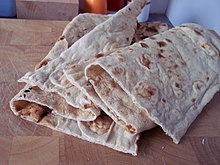Podpłomyk: Difference between revisions
remove {{Cleanup|date=December 2009}} |
H0lyh0lywiki (talk | contribs) No edit summary |
||
| Line 1: | Line 1: | ||
{{Infobox prepared food |
{{Infobox prepared food |
||
| name = Podpłomyk |
| name = Podpłomyk |
||
| image = |
| image = Afghan bread.jpg |
||
| caption = |
| caption = Prepared flatbread |
||
| alternate_name = |
| alternate_name = |
||
| country = [[Poland]] |
| country = [[Poland]] |
||
Revision as of 13:57, 7 November 2022
 Prepared flatbread | |
| Type | Flatbread |
|---|---|
| Place of origin | Poland |
| Main ingredients | Flour, water, salt |
Podpłomyk (Polish: plural: podpłomyki; German: fladen; Ukrainian: перепічка, perepichka, підпалок, pidpalok) is a simple kind of flat bread, often made without yeast.
Podpłomyk was a common kind of food in ancient Slavic societies, where it was made on stones heated up in a fire. Podpłomyki were also made in newer times by those who could not afford an enclosed stove. Before the mid-19th century, many poor Polish peasant homes had only open fireplaces, and the "thick" bread required careful heating in an oven; to overcome the problem, such ovens were sometimes communally-owned. Now podpłomyk, actually having never fully disappeared, has become popular again due to the interest in (pre-) medieval everyday life. Made of flour, water and salt, podpłomyki are often eaten with honey or "konfitury" (a kind of jam). Sometimes a podpłomyk was made to test the temperature of the baker's oven before the first batch of bread was made.

